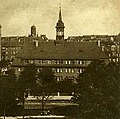City monastery Kiel
The Kiel city monastery emerged from four medieval hospitals in Kiel , which were merged in 1821.
history
Counts Johann I and Gerhard I von Holstein, sons of the Kiel city founder, Count Adolf IV , founded a hospital that was named “Holy Spirit Hospital” from around 1260 onwards. It followed the same rules as the Lübeck Holy Spirit Hospital . Travelers found accommodation in the hospital, and poor, old and weak people could live there permanently. Citizens and sovereigns gave the hospital donations from lands and villages, the proceeds of which were intended to provide for the needy in the city. After the Reformation , the hospital became a pure old people's and sick home. Over the years it had different locations within Kiel's old town.
In addition to the Holy Spirit Monastery, there was the St. Jürgenskloster on Sophienblatt (occupied since the 14th century), the Neugasthauskloster, founded in 1452 by Kiel mayor Henning von der Camer and his wife Beecke in a house on Holstenstraße, as well as the St. Anne's and Erasmikloster at the Schuhmachertor (occupied since 1600, but probably much older).
The administration of the hospitals was in the hands of the city council, which purposefully acquired villages in the area, the “city villages”, for their supply. However, the council members apparently often diverted the income for their own needs. From 1553 this led to a conflict with Duke Adolf , who demanded an account of the income from the foundations from the council. Ultimately, the duke leased the villages from the council and paid a fixed sum of money every year to maintain the hospitals in addition to the Kiel envelope . With the permutation contract of 1667, part of the town villages finally became princely property, with continued payment of the funds being promised.
Consolidation in the Sophienblatt
As early as the 17th and 18th centuries, efforts were made to merge the four hospitals. This was finally made possible from 1808 by the will of Henriette Friederica von Ellendsheim . In 1821/22 a new building was built on the Sophienblatt, on the grounds of the St. Juergens monastery, with rooms for 48 prebendists and apartments for two headmasters. An infirmary (nursing home) with four small apartments was housed in an adjoining building. The St. Juergens Chapel and St. Juergens Cemetery belonged to the monastery. Due to the great demand, the city monastery was expanded in 1865 by city architect Gustav Ludolf Martens by one floor and a tower, so that it could accommodate another 52 people.
New construction in Harmsstrasse
When the new Kiel Central Station was to be built in the immediate vicinity of the city monastery in 1895 , the city monastery board decided to move it. A plot of land in Harmsstrasse between Schützenwall and Zastrowstrasse opposite the Käthe-Kollwitz-Schule was acquired as a new location. The Kiel architect Johann Theede was responsible for the new building, which was inaugurated in 1909 . The garden was laid out by the municipal gardening inspector Ferdinand Hurtzig . The new city monastery offered 166 apartments for prebendists, as well as a hospital and nursing ward, apartments for nurses, prioresses and caretakers and a chapel. A tower tower with a clock was taken over from the Martens building and destroyed in the Second World War.
The bell of St. Juergens Church (1904–1954) with an inscription from 1530 was brought here when it was demolished.
The headquarters of the Kiel City Monastery Foundation are still located at this location and in this building.
More buildings
The Kurt-Engert-Haus, the Lisa-Hansen-Haus, the Andreas-Gayk-Haus, the Prof.-Weber-Haus, the Friederica-von Ellendsheim-Haus, the Haus Schwentineblick and the Prof. von Esmarch-Haus have been added .
Todays use
Today the city monastery in Kiel operates several senior citizens' homes and an outpatient care service. The building at Kiel's Südfriedhof is a listed building .
See also
literature
- Dietrich Metelmann: The Kiel city monastery. Commemorative publication for the inauguration of his new building on October 20th, 1909. Kiel, Handorf 1909.
- Doris Tillmann, Johannes Rosenplänter (Hrsg.): Kiel Lexikon. Wachholtz, Neumünster 2010, ISBN 978-3-529-02556-3 .
- Friedrich Volbehr: On the history of the former Kiel city villages. Kiel, Schmidt & Klaunig 1879. (News from the Society for Kiel City History 2)
Web links
Individual evidence
- ↑ Hedwig Sievert, Kiel then and now - From the canal to the Schwentine, G. Mühlau Verlag Kiel, 1964, Fig. 62 / 63a
Coordinates: 54 ° 19 ′ 11 ″ N , 10 ° 7 ′ 2.9 ″ E



